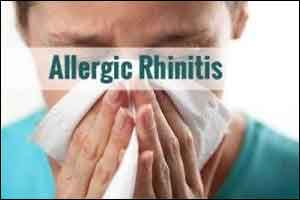- Home
- Editorial
- News
- Practice Guidelines
- Anesthesiology Guidelines
- Cancer Guidelines
- Cardiac Sciences Guidelines
- Critical Care Guidelines
- Dentistry Guidelines
- Dermatology Guidelines
- Diabetes and Endo Guidelines
- Diagnostics Guidelines
- ENT Guidelines
- Featured Practice Guidelines
- Gastroenterology Guidelines
- Geriatrics Guidelines
- Medicine Guidelines
- Nephrology Guidelines
- Neurosciences Guidelines
- Obs and Gynae Guidelines
- Ophthalmology Guidelines
- Orthopaedics Guidelines
- Paediatrics Guidelines
- Psychiatry Guidelines
- Pulmonology Guidelines
- Radiology Guidelines
- Surgery Guidelines
- Urology Guidelines
EAACI guidelines on the use of allergen immunotherapy

The European Academy of Allergy and Clinical Immunology (EAACI) has released guidelines on allergen immunotherapy (AIT).
The guidelines, published in the journal Allergy are aimed at healthcare professionals and should help them deliver better clinical care with more effective and safe use of AIT.
KEY RECOMMENDATIONS
Prevention
- A 3-year course of allergen immunotherapy (AIT) (subcutaneous immunotherapy [SCIT] or sublingual immunotherapy [SLIT]) can be considered in children with moderate to severe allergic rhinitis and grass/birch pollen allergy, not sufficiently controlled with optimal pharmacotherapy, for short-term and possibility long-term prevention of asthma symptoms in addition to improving the control of AR.
- Only AIT products with documented effect in patients with the relevant pollen allergy should be used, and a product-specific evaluation of clinical efficacy and preventive effects are recommended.
- Before initiating AIT, the possible benefits including the beneficial effects of controlling allergic rhinitis symptoms and the asthma preventive effect, disadvantages, potential harms, patients’ preferences (SCIT or SLIT-tablets/SLIT-drops), and patients’ adherence to treatment and costs should be discussed with the patient/family on an individual basis.
- There is an urgent need for more high-quality clinical trials on prevention in AIT.
Venom
- Venom immunotherapy (VIT) is indicated in venom allergic individuals following moderate to severe systemic reactions.
- VIT is also recommended to reduce systemic allergic reactions in adults with skin symptoms only when the quality of life is impaired.
- VIT is safe for patients with special conditions, such as mastocytosis.
- Pretreatment with H1 antihistamines should be used to prevent large local reactions.
- A 12-week maintenance injection interval can be recommended in lifelong VIT.
- A 200 µg maintenance dose should be used for patients still reacting while on a conventional (100 µg) dose.
- Lifelong VIT can be recommended in patients at high risk of relapse.
- Considerable gaps were identified in the evidence base emphasizing the need for future well-designed studies, particularly in the pediatric population.
IgE-mediated food allergy
- Allergen Immunotherapy for food allergy (FA-AIT) should only be performed by experienced personnel in research centers or in clinical centers with an extensive experience in food allergy AIT.
- Food allergy-allergen immunotherapy (FA-AIT) should be considered for children from around 4-5 years of age with a persistent IgE-mediated food allergy to cow’s milk (Grade A), hen’s egg or peanut to increase the threshold of reactivity while on therapy. A benefit post-discontinuation is suggested but not confirmed.
- Oral immunotherapy (OIT) affords better efficacy than sublingual immunotherapy (SLIT), but OIT is associated with higher frequency of adverse events than SLIT although most are not severe.
- The initial FA-AIT dosage and each increased dosage during the build-up phase should be performed in the clinical setting.
- Patients and their families should be provided with information about the use of AIT for IgE-mediated food allergy to allow them to make an informed decision about the therapy.
- Longitudinal, prospective, well-designed studies are needed to fill the many gaps yet to be addressed with the final goal of extending FA-AIT protocols in clinical practice as standard medical therapy.
- There is a paucity of evidence for use of FA-AIT in adults.
Allergic rhinoconjunctivitis
- AIT should be considered in patients with allergic rhinitis (AR), with or without conjunctivitis; evidence of IgE-sensitization to 1 or more clinically relevant allergens; and moderate to severe symptoms despite regular and/or avoidance strategies.
- An individual product-based evaluation of evidence for efficacy is recommended before treatment with a specific product is initiated.
- The following can be recommended for AR for short-term benefit:
- Continuous SCIT for seasonal or perennial allergens
- Pre- and pre-/coseasonal SCIT
- Modified (allergoids) and unmodified allergen SCIT extracts
- SLIT aqueous solutions for grass and tree pollens
- The following can be recommended for AR for short- and long-term benefits:
- Continuous grass pollen SCIT
- Continuous grass pollen SLIT-tablets or SLIT solution
- HDM SLIT-tablet (but not an aqueous solution) for short-term and long-term benefits
- To achieve long-term efficacy, it is recommended that a minimum of 3 years of therapy is used.
- SCIT and initial SLIT dosage should be administered by competent staff with patients waiting in the clinic for at least 30 minutes after dose.
- Many gaps in the evidence base exist, particularly around long-term benefit and use in children.
For further reference follow the link: http://onlinelibrary.wiley.com/doi/10.1111/all.13420/epdf
birchEuropean Academy of Allergy and Clinical ImmunologyFoodgrassIgEimmunotherapyPHARMACOTHERAPYpollenreactionssublingualvenom
Source : With inputs from AllergyNext Story
NO DATA FOUND

Disclaimer: This site is primarily intended for healthcare professionals. Any content/information on this website does not replace the advice of medical and/or health professionals and should not be construed as medical/diagnostic advice/endorsement or prescription. Use of this site is subject to our terms of use, privacy policy, advertisement policy. © 2020 Minerva Medical Treatment Pvt Ltd